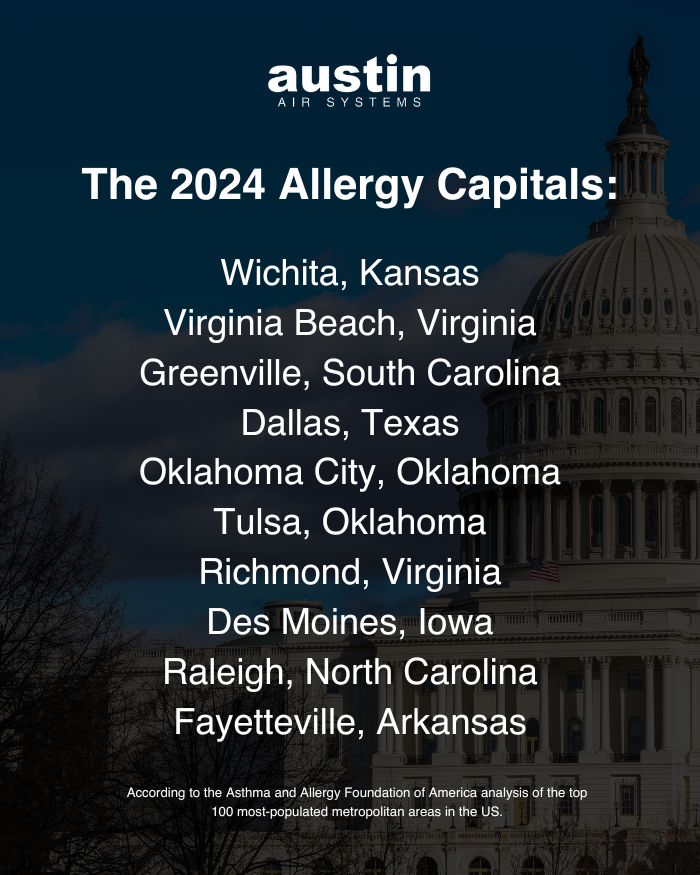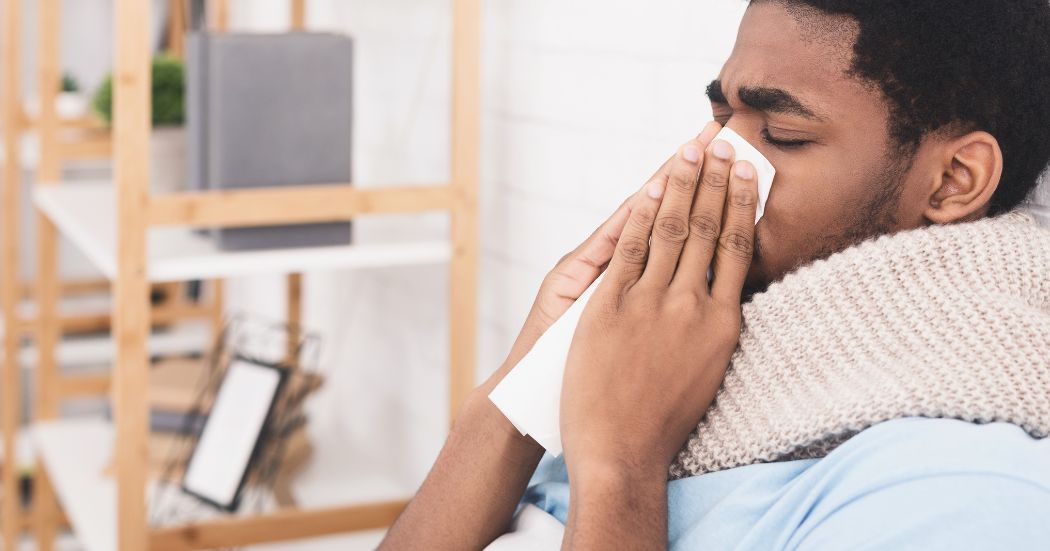The vernal equinox was Tuesday meaning spring has officially sprung! Soon we’ll be enjoying warmer temperatures and blooming flowers. Unfortunately, for many of us, seasonal allergies will also be here. As nature awakens from its winter slumber, so too do the plants that release the pollen which triggers sneezing fits and itchy eyes.
And it’s time to brace yourselves folks: experts ranging from the U.S. Department of Health and Human Services to the meteorologists at AccuWeather are warning that spring allergy season 2024 will be earlier AND more intense than usual in many parts of the United States and Canada.123
In this blog post, we’ll delve into what exactly makes this upcoming allergy season different, why some regions are expected to bear the brunt of it more than others, and most importantly, what you can do to prepare and alleviate those pesky allergy symptoms. Before you stock up on tissues, join us as we navigate through the soon-to-be pollen-filled air of spring 2024!
Why Are Spring Allergies Worse This Year?
Winter and spring temperatures greatly influence springtime pollen release. Plants must have enough warmth in order to come out of dormancy, grow flowers, and release pollen. 2024’s unusually warm winter temperatures are causing plants to leaf earlier than usual and pollen release will soon follow, prolonging the allergy season. Additionally, increased rainfall can lead to more plant growth and higher pollen levels which is also happening this year.
Generally, plants will begin to release pollen about two weeks after the first leaves appear – which is (appropriately) known as “leafing.” Lilac and honeysuckles provide the first insight as to when we can expect spring because they are woody plants which show their leaves and then bloom before many other plants. They also grow throughout the entire country, which makes them excellent indicators of what is to come.
According to the USA National Phenology Network (USA-NPA), this year plants are leafing earlier than ever recorded in places such as the Northern California coast, the Sacramento Valley, Washington, Oregon, the southern Midwest, and sections of the Great Plains.4
How early? Some specific examples include:
- Cleveland, Ohio – 16 days early
- Des Moines, Iowa – 20 days early
- Detroit, Michigan – 23 days early
But this spring’s earlier and more intense seasonal allergies linked to a winter that was warmer in some areas and wetter in others isn’t just a fluke of Mother Nature. There are two major culprits which are the source of the intense spring allergy season that is about to begin: El Niño and climate change.
El Niño 2024
El Niño is a weather phenomenon characterized by the abnormal warming of sea surface temperatures in the central and eastern Pacific Ocean near the equator. During an El Niño year, the changes in ocean temperatures alter atmospheric circulation patterns, leading to shifts in precipitation and temperature patterns – which has widespread effects on weather patterns around the globe.5
In the US, El Niño winters are generally warmer and wetter than usual.
Climate Change
The World Meteorological Organization has reported record winter temperatures – on land and in the ocean – throughout the planet.6
This is linked to climate change. The effects of climate change are also more extreme due to El Niño, which has translated to an even warmer winter, more days without frost, and more carbon dioxide in the atmosphere.
Now that extra warmth and moisture are altering the severity and timing of seasonal allergies by stimulating plant growth and increasing pollen production.
Climate change plus El Nino increased the severity of the atmospheric rivers that drenched Southern California this winter, now the two are working together to punish our sinuses.7
Where Will Spring Allergies Be The Worst?
As you’re reading this you might be wondering – how will my city stack up this spring? In Buffalo, New York, where Austin Air is based, we enjoyed a pretty mild winter (minus two record breaking, back-to-back snow events in January) and the crocuses started to sprout weeks ago but this week we’re being hammered with gnarly winter weather again so we’re “safe” from pollen-based sniffles for a little while longer… but extending the conditions ideal for the flu (some say early spring is a second flu season, just as bad as early winter).
The Asthma and Allergy Foundation of America has done an analysis of the top 100 most-populated metropolitan areas in the US and determined that the top 10 toughest places to live for seasonal allergy sufferers or “Allergy Capitals 2024” include:
- Wichita, Kansas
- Virginia Beach, Virginia
- Greenville, South Carolina
- Dallas, Texas
- Oklahoma City, Oklahoma
- Tulsa, Oklahoma
- Richmond, Virginia
- Des Moines, Iowa
- Raleigh, North Carolina
- Fayetteville, Arkansas8

How to Avoid Seasonal Allergies?
Spring allergies are a reaction to tree pollen. Pollen is more than just an irritating airborne allergen that causes sneezing, nasal congestion, and runny nose as well as irritation, redness, or itching of the eyes. Pollen exposure can incite several allergic reactions, aggravating asthma or other respiratory conditions.
These symptoms have been associated with detrimental effects on sleep quality, daily functioning, productivity, focus, and overall well-being. Allergic asthma and seasonal allergies impact approximately 40% of the population in the United States.
Here at Austin Air we like to offer more than condolences for anyone dealing with the frustration of seasonal allergies, especially this year when it’s expected to be especially bad. Below is some basic advice on how to make the most out of a challenging time:
Watch Pollen Counts and Avoid the Outdoors: Just like checking the weather, keep track of the pollen forecast. In fact, your favorite weather app likely has information on pollen counts. On days with high pollen counts, avoid spending time outdoors. This can be hard when the weather is nice after a long winter but your body will thank you for it.
Change Your Clothes and Shower Daily: This advice might be the default hygienic practice for many people but when pollen counts are at their highest, it is crucial to take a “decontamination shower” once you get home and to wash the clothes you wore. Ideally, you’ll shower and change into clean clothes as soon as you get home. Make sure to wash your hair too. If you don’t shower right away, avoid sitting on any furniture in your soiled clothing. Certain items which you don’t normally wash after a single wear, like jackets or thick sweatshirts, should be kept near the door and only worn as needed.
Wear Sunglasses To Protect Your Eyes from Pollen: Wraparound sunglasses are best for this because they sit closer to the face than other styles. Some experts even suggest wearing sunglasses at night! For safety reasons, don’t do this when you drive or get night driving anti-glare glasses.
Keep Your Windows Closed: It might be challenging to resist airing out the house on a sunny and breezy spring day but you’ll be filling your house with pollen, which will linger well after the windows are closed.
Start Using Nasal Spray Now: Medications aren’t our favorite – the goal to find non-pharmaceutical methods to increase respiratory health led to the invention of the Austin Air cleaners – but we know that many people reading this turn to certain nasal sprays for help during allergy season, which can provide much needed relief. These products typically need to be used over a period of time in order to be effective. Start use now, on the cusp of allergy season, so your sinuses are ready for the worst of it.
Use An Austin Air Purifier: All of the standard-sized Austin Air cleaners are equipped with HEPA and 15 pounds of activated carbon which will remove pollen – and other common allergens – from your home. During the height of spring allergies, sleep with it next to your bed to ensure a restful sleep.
This advice isn’t just for the spring pollen season – it’ll help with summer and autumn allergies too. It’s also imperative for folks with asthma or other respiratory conditions to do their best to avoid allergens, to prevent severe respiratory distress.
And although there seems to be consensus among the experts that spring allergies will be bad this year (and unfortunately – summer too), we’ve still got our fingers crossed that they’ll be wrong. Take care of yourselves in the meantime.

REFERENCES
1 Pollen. (2024, March 5). US Department of Health and Human Services. https://www.hhs.gov/climate-change-health-equity-environmental-justice/climate-change-health-equity/climate-health-outlook/pollen/index.html.
2 Lada, B. (2024, March 20). US allergy forecast for 2024 calls for 3 peaks in pollen. AccuWeather. https://www.accuweather.com/en/health-wellness/us-allergy-forecast-for-2024-calls-for-3-peaks-in-pollen/1632390.
3 Lang, E. (2024, March 19). Allergies acting up already? Mild winter to blame for early pollen release in southern Ontario. CBC. https://www.cbc.ca/news/canada/toronto/allergies-toronto-2024-1.7147179
4 Status of Spring (2024, March 18.). USA National Phenology Network. https://www.usanpn.org/data/maps/spring.
5 El Niño and La Niña: Frequently asked questions. (2016, January 18). NOAA Climate.gov. https://www.climate.gov/news-features/understanding-climate/el-niño-and-la-niña-frequently-asked-questions.
6 El Niño weakens but impacts continue. (2024, March 4). World Meteorological Organization.https://wmo.int/news/media-centre/el-nino-weakens-impacts-continue.
7 Borunda, A. (2024, February 7). Another atmospheric river has soaked California. What role has climate change played? NPR. https://www.npr.org/2024/02/06/1229226051/how-are-atmospheric-rivers-affected-by-climate-change.
8 How the Top 100 U.S. Cities Rank for Seasonal Pollen Allergies. (2024, March 14). Asthma & Allergy Foundation of America. https://aafa.org/asthma-allergy-research/allergy-capitals/.
